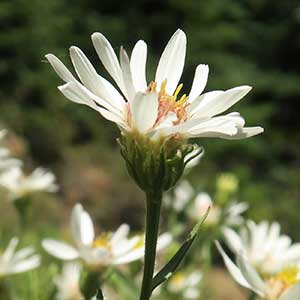Eucephalus paucicapitatus
Eucephalus
Olympic mountain-aster
aster
ascending to erect, pilose or glandular-pubescent.
ascending or erect, simple, glabrate, puberulent, pilose, cottony, or woolly, eglandular or glandular.
mid and distal blades elliptic to elliptic-oblong, 2–4 cm × 4–13 mm, sparsely scabrous to stipitate-glandular abaxially, moderately stipitate-glandular adaxially.
cauline; alternate;
sessile (proximal withering by flowering; proximalmost reduced, scalelike);
blades (1-nerved) ovate, elliptic, oblong, lanceolate, or linear (± uniform in size), margins entire, faces glabrate, scabrous, cottony, or woolly, eglandular or stipitate-glandular.
stipitate-glandular.
turbinate-obconic, 7–9 mm.
turbinate-cylindric, turbinate, turbinate-obconic, or campanulate, 10–25 mm diam.
± flat, pitted, epaleate.
0–21 (usually 5, 8, or 13), pistillate, fertile;
corollas violet-purple, purple, pink, or white.
10–35, bisexual, fertile;
corollas yellow, ± ampliate, tubes shorter than funnelform throats, lobes 5, erect or reflexed, triangular;
style-branch appendages lanceolate.
in 2–3 series (whitish), lance-linear (unequal), apices acute, abaxial faces stipitate-glandular.
20–50 in 3–6 series, ± unequal (± appressed, often reddish or purplish at margins and tips), 1-nerved (keeled), ovate, lance-oblong, lanceolate, linear-oblong, or linear, chartaceous at bases, margins sometimes hyaline, especially proximally;
apices acute to obtuse, green, usually puberulent, tomentose, and/or stipitate-glandular, sometimes glabrous.
usually 2–4 in racemiform to corymbiform arrays, somtimes borne singly.
radiate or discoid, usually in open, racemiform, paniculiform, or corymbiform arrays, sometimes borne singly.
obconic, pilose;
pappus bristles in 2 series, ± barbellate.
± obconic, flattened, laterally 1–2-ribbed, sometimes with 1–2 additional nerves on each face, glabrous, pilose, or strigose, eglandular;
pappi persistent, of 30–50 whitish to tawny, barbellate or smooth, apically clavate or more conspicuously barbellate bristles in 2(–3) series (outer usually 1 mm or less, sometimes 0, inner 5–10 mm).
7–13(–21), white.
= 9.
Eucephalus paucicapitatus
Eucephalus
Eucephalus paucicapitatus is found on Vancouver Island, where it is very uncommon, and the Olympic Peninsula. It is closely related to E. gormanii.
(Discussion copyrighted by Flora of North America; reprinted with permission.)
Species 10 (10 in the flora).
Eucephalus, a relatively well-marked western North American group, has been treated as a section of Aster or as a distinct genus. Recent molecular evidence places Eucephalus, together with the eastern North American Doellingeria, at the base of the North American clade of Astereae.
(Discussion copyrighted by Flora of North America; reprinted with permission.)
1. Ray florets usually 1–4, often 0 | → 2 |
1. Ray florets commonly 5, 8, or 13+ | → 5 |
2. Ray florets 0; leaves 5–9 cm, ± glabrous abaxially, glandular adaxially; plants 60–120 cm; open woods, Lane County, Oregon | E. vialis |
2. Ray florets usually 1–4; leaves 2–6 cm, hairy; plants 10–100 cm | → 3 |
3. Leaves glabrous or nearly so abaxially, moderately to densely hairy adaxially | E. tomentellus |
3. Leaves glabrous, eglandular or sparsely glandular on both faces | → 4 |
4. Phyllaries subequal | E. breweri |
4. Phyllaries strongly unequal | E. glabratus |
5. Stems, leaves, and phyllaries glabrous, glaucous; plants 40–160 cm; leaves linear tonarrowly lance-elliptic, 4–10 cm; rays purple | E. glaucescens |
5. Stems, leaves, and phyllaries pubescent or glabrate, glandular or not, not glaucous; plants 10–120(–150) cm; leaves elliptic, oblong, lance-ovate, lance-elliptic, lanceolate, linear-oblong or -lanceolate, 1.5–10 cm; rays white, pink, violet, or purple. | → 6 |
6. Leaves 5–10 cm, elliptic to lanceolate, glabrous and eglandular, or abaxially ± glandular and/or villous; plants 50–150 cm; rays white to pink | E. engelmannii |
6. Leaves 1.5–7 cm, elliptic, elliptic-oblong, oblong, lance-ovate, lance-elliptic, linear-oblong or -lanceolate, glandular or not, scabrous or cottony; plants 10–80 cm; rays white or violet to purple | → 7 |
7. Rays white; stems pilose or sparsely to moderately glandular-pubescent | → 8 |
7. Rays violet to purple; stems scabrous (to scabrellous) or cottony and/or glandular-pubescent (especially peduncles) | → 9 |
8. Phyllaries lance-ovate; Cascade Mountains, Oregon | E. gormanii |
8. Phyllaries lance-linear; Olympic Mountains, Washington | E. paucicapitatus |
9. Leaves moderately scabrellous (and sometimes glandular) on both faces | E. elegans |
9. Leaves sparsely scabrous abaxially, strongly cottony adaxially | E. ledophyllus |


